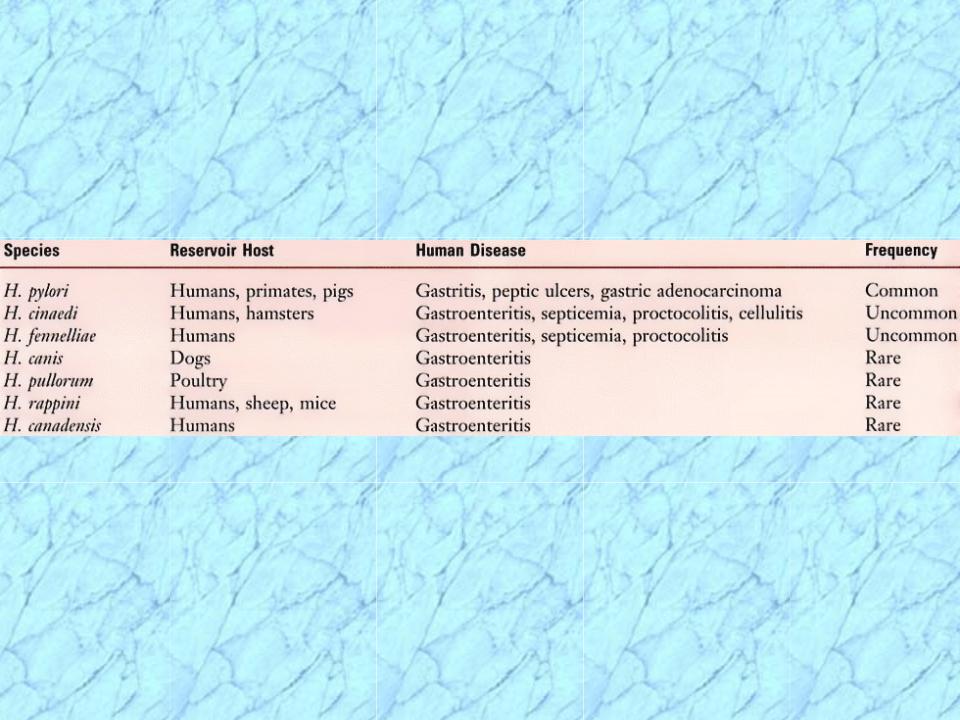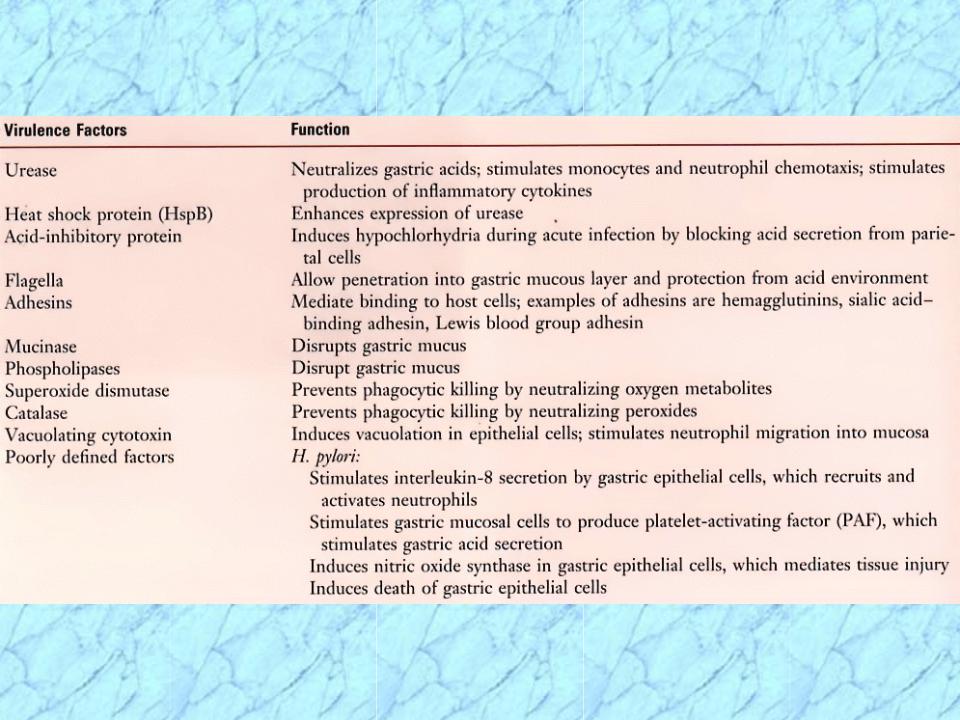
- •Campylobacter &
- •General Characteristics
- •History of Campylobacter
- •Morphology & Physiology of Campylobacter
- •Campylobacter Species Associated
- •Guillain-Barre Syndrome (GBS)
- •Epidemiology of Campylobacteriosis
- •Epidemiology of Campylobacteriosis(cont.)
- •Epidemiology of Campylobacteriosis(cont.)
- •Pathogenesis & Immunity
- •Putative Virulence Factors
- •Laboratory Identification
- •Laboratory Identification (cont.)
- •Treatment, Prevention & Control
- •History & Taxonomy of Helicobacter
- •General Characteristics of Helicobacter
- •Morphology & Physiology of
- •Helicobacter on Paramagnetic Beads
- •Helicobacter Species Associated
- •Epidemiology of Helicobacter Infections
- •Epidemiology of Helicobacter Infections (cont.)
- •Pathogenesis of Helicobacter Infections
- •Virulence Factors of Helicobacter
- •Virulence Factors of Helicobacter
- •Urea Hydrolysis
- •Virulence Factors of Helicobacter (cont.)
- •Laboratory Identification
- •Treatment, Prevention & Control
- •REVIEW
- •General Characteristics
- •Campylobacter Review
- •History of Campylobacter
- •REVIEW
- •REVIEW
- •Morphology & Physiology of Campylobacter
- •Campylobacter Species Associated
- •Guillain-Barre Syndrome (GBS)
- •Epidemiology of Campylobacteriosis
- •Epidemiology of Campylobacteriosis(cont.)
- •Epidemiology of Campylobacteriosis(cont.)
- •Helicobacter Review
- •History & Taxonomy of Helicobacter
- •General Characteristics of Helicobacter
- •REVIEW
- •REVIEW
- •Morphology & Physiology of
- •Helicobacter Species Associated
- •Epidemiology of Helicobacter Infections
- •Epidemiology of Helicobacter Infections (cont.)
- •Pathogenesis of Helicobacter Infections
- •Virulence Factors of Helicobacter
- •Treatment, Prevention & Control

Helicobacter Species Associated
with Human Disease

Epidemiology of Helicobacter Infections
Family Clusters
Orally transmitted person-to-person (?)
Worldwide:
~ 20% below the age of 40 years are infected
50% above the age of 60 years are infected
H. pylori is uncommon in young children

Epidemiology of Helicobacter Infections (cont.)
Developed Countries:
United States: 30% of total population infected
•Of those, ~1% per year develop duodenal ulcer
•~1/3 eventually have peptic ulcer disease(PUD)
70% gastric ulcer cases colonized with H. pylori
Low socioeconomic status predicts H. pylori infection
Developing Countries:
Hyperendemic
About 10% acquisition rate per year for children between 2 and 8 years of age
Most adults infected but no disease
•Protective immunity from multiple childhood infections

Pathogenesis of Helicobacter Infections
Colonize mucosal lining of stomach & duodenum in man & animals
•Adherent to gastric surface epithelium or pit epithelial cells deep within the mucosal crypts adjacent to gastric mucosal cells
•Mucosa protects the stomach wall from its own gastric milleu of digestive enzymes and hydrochloric acid
•Mucosa also protects Helicobacter from immune response
Most gastric adenocarcinomas and lymphomas are concurrent with or preceded by an infection with
H. pylori

Virulence Factors of Helicobacter

Virulence Factors of Helicobacter
Multiple polar, sheathed flagella
•Corkscrew motility enables penetration into viscous environment (mucus)
Adhesins: Hemagglutinins; Sialic acid binding adhesin; Lewis blood group adhesin
Mucinase: Degrades gastric mucus; Localized tissue damage
Urease converts urea (abundant in saliva and
gastric juices) into bicarbonate (to CO2) and ammonia
•Neutralize the local acid environment
•Localized tissue damage
Acid-inhibitory protein

Urea Hydrolysis
|
Urease |
||
C=O(NH2)2 + H+ + |
2H2O HCO3- + 2 (NH4+) |
||
Urea |
|
|
Bicarbonate |
Ammonium |
|
|
|
ions |
|
|
|
And then… |
|
|
|
HCO |
- CO |
2 |
+ OH- |
3 |
|
|
|

Virulence Factors of Helicobacter (cont.)
Tissue damage:
Vacuolating cytotoxin: Epithelial cell damage
Invasin(s)(??): Poorly defined (e.g., hemolysins; phospholipases; alcohol dehydrogenase)
Protection from phagocytosis & intracellular killing:
Superoxide dismutase
Catalase

Laboratory Identification
Recovered from or detected in endoscopic antral gastric biopsy material; Multiple biopsies are taken
Many different transport media
Culture media containing whole or lysed blood
Microaerophilic
Grow well at 37oC, but not at 25 nor 42oC
Like Campylobacter, does not use carbohydrates, neither fermentatively nor oxidatively

Treatment, Prevention & Control
Triple Chemotherapy (synergism):
Proton pump inhibitor (e.g., omeprazole = Prilosec(R))
One or more antibiotics (e.g., clarithromycin; amoxicillin; metronidazole)
Bismuth compound
Inadequate treatment results in recurrence of symptoms

